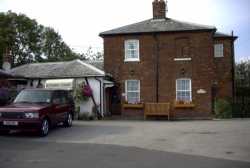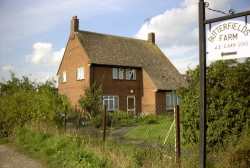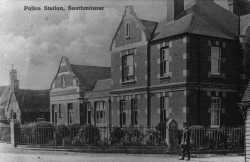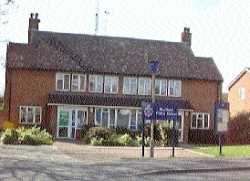Policing History
Since the formation of modern police forces in about 1840 many family trees feature a relative whose occupation is listed as Police Constable.
This page provides some details of the history of policing in Eastern Essex.
Until 1840 law enforcement was in the hands of elected part time Parish Constables who were responsible for bringing offenders before local Magistrates or for trial at Quarter Sessions held at Chelmsford.

The old village lock up at Bradwell which was built in 1817 for detention of adults and juveniles still exists
The lock up at Bradwell-on-Sea was built in 1817 by Samuel Horne at the cost of £3 10 shillings 9 pence and the pillory added to in 1823 by attachment of stocks to the outside. When the Constable had a busy time six prisoners could be accommodated inside the cage and up to 5 people attached to the pillory to become objects of pity or derision to passers by. One ring on the pillory is very low making it suitable for use with small children.
Serious cases were kept in the lock up and then taken to the assizes by the Constable.
The Parish Constables faced a difficult and dangerous job as is evidenced by the case of Peter Jerome who was a gentleman of Woodham Mortimer who attacked a Parish Constable with his dagger drawing blood for which offence she received a fine of six shillings and eight pence.
On 11 February 1840 Essex agreed to
adopt a police rate that would allow the formation of Essex County
Constabulary.
The initial recruits included PC 20 William Aubrey a baker from Stow
Maries, PC 58 Charles Fletcher the Parish Constable from Tillingham
and PC 35 James Holby a corn dealer from Latchingdon.
Also amongst the first recruits was Andrew Rome who was a 22 yr old
former tea dealer from Scotland. Andrew Rome was subsequently
promoted to Inspector where he commanded the Essex Police Unit
responsible for policing the oyster beds at Burnham on Crouch until
his retirement in 1897. His 57 years of service is a record that is
unlikely to be beaten.
The initial deployment of men saw 14 Police Divisions which included
Dengie Division controlling the Dengie 100 area. This Division was
commanded by ex Army Officer Superintendent John Hawkins with one
Constable at Latchingdon, 2 Constables at Southminster and 1
Constable at Bradwell on Sea.
Latchingdon Station and Court House 1443 - 1995
Roger and Lesley Cook who are the
current owners of Butchers corner have been kind enough to supply a
brief history of this interesting building for the period 1840 to
1930 .
Although the building is sited in the Street on the western edge of
Latchingdon Village and is known as Latchingdon Police Station it is
actually within the boundary of Purleigh Parish.
In 1841 a plot of land was purchased from Mr Samuel Clift for £60
and agreement was reached with Mr Haywood from Colchester to
build a Police Station for �1,100. In the manner of the day brick
for the Police Station were built locally by Richard Solly at Mundon
Hall Farm for 9 shillings per thousand including transport to the
site. These locally made bricks are still in good condition over 160
years later.

The new police Station was
formally opened in 1843 making it one of the first Police stations
in both the county and the country.
The building consisted of two cells, a guard room, Superintendent's
kitchen and parlour and bedrooms/social rooms for the men stationed
at Latchingdon.
At this time the manpower of the Dengie Division was a Superintendent at Latchingdon, and Inspector at Southminster and one Constable at Latchingdon, Southminster, Purleigh, Tillingham, Burnham and Bradwell.
By 1850 the complex was extended to include a Court House where a Petty Sessions Court was held.

In 1851 residents included Superintendent Francis Knock, his wife Amelia and their 7 children plus Police Constable William Peacock, his wife Susannah and their 3 children.
Police strength in the Dengie Division had by then risen to a Superintendent at Latchingdon, an Inspector and two constables at Burnham Oyster Company and a Constable at Latchingdon, Southminster, Steeple, Purleigh, Woodham Walter, Woodham Ferrers, Althorne, Tillingham and Burnham.
By 1867 The Divison was run by Superintendent George Rutledge with one Inspector and 13 Constables.
On 7 August 1886 Police Constable 213 Edward Raven was returning to Foulness in a small boat when it capsized in the strong breeze, and he was drowned.
Police Constable Edward Raven was born at Steeple in Essex, working as a labourer prior to becoming a policeman when he was 23; his brother Elijah joined the City of London Police.
Edward Raven's first posting was to Chelmsford till June 1863, but for the next 20 years he was one of the Essex police officers whose wages were paid by the Burnham Oyster Company to protect their fisheries; it seems likely that he already had some previous knowledge of boats from his upbringing in a riverside village. In 1882 the Burnham Oyster Company reduced the number of its officers, and Edward Raven worked in his birthplace before volunteering for the Foulness beat.
Click here to visit the Essex Police Memorial Site which lists all Police Officers who died on duty in Essex.
Policing
demands in the area continued to grow throughout the Dengie 100 to
the extent that Latchingdon Police Headquarters and Court was not
large enough.
By 1888 whilst the number of Constables remained unchanged Dengie Division consisted of a further Inspector and three Sergeants.
Click here to see a muster list of names and stations of the members of the Dengie Division in 1888
In 1902 a new Divisional HQ and
Magistrates Court was built at Southminster and Latchingdon reverted
to the residence and office of the local constable until the 1930s.
In more recent times Latchingdon had a modern Police House which
provided the residence and Office of a Constable.

Changing methods within Essex Police meant
that in the mid 1990's the Police House was sold to private
ownership ending 150 years of police presence in the village.
Southminster Police Station 1902-2018

The opening of Southminster Police Station
and the attached Courthouse moved the HQ of the Dengie Division to
Southminster.
The new Police Station included 4 cells lit by gas light and an
exercise yard with toilets which represented a considerable advance
in the treatment of prisoners.
To the rear of the building were stables with hay loft for the
Superintendents pony and trap.
Manpower had more than trebled since 1840 with a Superintendent, an
Inspector, three Sergeants and 14 Constables to police the Dengie
Division.
In 1914 reorganisation of Essex Police meant that the Dengie Division which has by then grown to 23 Officers was to disappear as a Section of the Rochford Division commanded by an Inspector based at Southminster.
Click here for details of some of the crimes dealt with by Southminster Police .
Southminster Magistrates
Court was closed in the mid 1980's and has been converted to a
library. The contents of the Courthouse have been taken to Essex
Police Museum where they provide one of the many interesting
exhibits.
Southminster Police Station has received several refurbishment's but
remains the centre for policing the Dengie 100.
Wartime
Burnham Police Station has been in several sites including Albert Road where the below photograph was taken. The Police station is now a private house.
|
|
1944 - Victory Photograph of Burnham Police The Regular Officers are led by Inspector Rose The Specials include Tubby Barker and the far left and Albie Rice 2nd from right at rear. |
The Police took on a co-ordinating role in World War 2 .
By World War 2 Southminster was no longer a Division but part of the Maldon area.
A Sergeant was now in charge of the Southminster area with an Inspector at Maldon.
Police Stations were located at Bradwell on Sea, Burnham on Crouch, Latchingdon, Purleigh and Southminster.
During the war the Police Strength of Maldon/ Southminster area was 14 regular Constables, 44 Special Constables and 4 vehicles were allocated for Police use.
In response to concern about bombing the Home Office offered the following guidance to the rural parishes:- Each parish should depend upon
1/ A Police Constable with protective clothing 2/ Two or three volunteer Special Constables
3/ Three air raid wardens for each 500 people of the population 4/ A first aid post
5/ Voluntary help from the men of the village 6/ The trained sense of the village
Burnham, Police Station Station Road
A new Police Station was built in Station Road in the late 1960's which today serves as a centre for Essex Police Marine Unit who operate a police launch and several fast inflatables in the Rivers Crouch and Blackwater.

Burnham Oyster Company Police
Burnham Oyster Company was formed by the owners of the Burnham Oyster beds which were reckoned amongst the best in the country during the 1800's. To protect the oyster beds from theft and damage five Officers were attached to the Oyster Company.
In 1863 the Officers were Inspector Andrew Rome and Constables William Piper, William Rogers,William Wallace and Richard Wilsteed.


